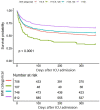Association Between Obesity and Short-And Long-Term Mortality in Patients With Acute Respiratory Distress Syndrome Based on the Berlin Definition
- PMID: 33643222
- PMCID: PMC7907504
- DOI: 10.3389/fendo.2020.611435
Association Between Obesity and Short-And Long-Term Mortality in Patients With Acute Respiratory Distress Syndrome Based on the Berlin Definition
Abstract
Purpose: Acute respiratory distress syndrome (ARDS) is one of the most common causes of death in intensive care units (ICU). Previous studies have reported the potential protective effect of obesity on ARDS patients. However, these findings are inconsistent, in which less was reported on long-term prognosis and diagnosed ARDS by Berlin definition. This study aimed to investigate the relationship between obesity and short-term and long-term mortality in patients with ARDS based on the Berlin Definition.
Methods: This is a retrospective cohort study from the Medical Information Mart for Intensive Care III (MIMIC-III) database, in which all the patients were diagnosed with ARDS according to the Berlin definition. The patients were divided into four groups according to the WHO body mass index (BMI) categories. The multivariable logistic regression and Cox regression analysis were used to investigate the relationship between BMI and short-term and long-term mortality.
Result: A total of 2,378 patients with ARDS were enrolled in our study. In-hospital mortality was 27.92%, and 1,036 (43.57%) patients had died after 1-year follow-up. After adjusting for confounders, the in-hospital and 1-year mortality risks of obese patients were significantly lower than those of normal weight (OR 0.72, 95%CI 0.55-0.94, P=0.0168; HR 0.80, 95%CI 0.68-0.94 P=0.0084; respectively), while those mortality risks of underweight patients were higher than normal weight patients (P=0.0102, P=0.0184; respectively). The smooth curve showed that BMI, which was used as a continuous variable, was negatively correlated with in-hospital and 1-year mortality. The results were consistent after being stratified by age, gender, race, type of admission, severity of organ dysfunction, and severity of ARDS. The Kaplan-Meier survival curves showed that obese patients had significant lower 1-year mortality than normal weight patients.
Conclusion: We found that obesity was associated with decreased risk of short-term and long-term mortality in patients with ARDS.
Keywords: 1-year mortality; 28-day mortality; ARDS; body mass index; obesity.
Copyright © 2021 Zhang, Wang, Li and Wang.
Conflict of interest statement
YW was employed by the company Ruibiao (Wuhan) Biotechnology Co. The remaining authors declare that the research was conducted in the absence of any commercial or financial relationships that could be construed as a potential conflict of interest.
Figures




Similar articles
-
Association of obesity on short- and long-term survival in patients with moderate to severe pneumonia-related ARDS: a retrospective cohort study.BMC Pulm Med. 2025 Apr 3;25(1):153. doi: 10.1186/s12890-025-03614-z. BMC Pulm Med. 2025. PMID: 40181311 Free PMC article.
-
Body mass index and acute kidney injury in the acute respiratory distress syndrome.Crit Care Med. 2012 Sep;40(9):2601-8. doi: 10.1097/CCM.0b013e3182591ed9. Crit Care Med. 2012. PMID: 22732288 Free PMC article.
-
[Predictive value of machine learning for in-hospital mortality for trauma-induced acute respiratory distress syndrome patients: an analysis using the data from MIMIC III].Zhonghua Wei Zhong Bing Ji Jiu Yi Xue. 2022 Mar;34(3):260-264. doi: 10.3760/cma.j.cn121430-20211117-01741. Zhonghua Wei Zhong Bing Ji Jiu Yi Xue. 2022. PMID: 35574742 Chinese.
-
Can body mass index predict clinical outcomes for patients with acute lung injury/acute respiratory distress syndrome? A meta-analysis.Crit Care. 2017 Feb 22;21(1):36. doi: 10.1186/s13054-017-1615-3. Crit Care. 2017. PMID: 28222804 Free PMC article. Review.
-
Acute respiratory distress syndrome: the Berlin Definition.JAMA. 2012 Jun 20;307(23):2526-33. doi: 10.1001/jama.2012.5669. JAMA. 2012. PMID: 22797452
Cited by
-
Associations of body mass index, fasting insulin, and inflammation with mortality: a prospective cohort study.Int J Obes (Lond). 2022 Dec;46(12):2107-2113. doi: 10.1038/s41366-022-01211-2. Epub 2022 Aug 27. Int J Obes (Lond). 2022. PMID: 36030344 Free PMC article.
-
Effects of acetaminophen use on mortality of patients with acute respiratory distress syndrome: secondary data mining based on the MIMIC-IV database.BMC Pulm Med. 2024 Nov 14;24(1):568. doi: 10.1186/s12890-024-03379-x. BMC Pulm Med. 2024. PMID: 39543557 Free PMC article.
-
A propensity score-matching analysis of angiotensin-converting enzyme inhibitor and angiotensin receptor blocker exposure on in-hospital mortality in patients with acute respiratory failure.Pharmacotherapy. 2022 May;42(5):387-396. doi: 10.1002/phar.2677. Epub 2022 Apr 8. Pharmacotherapy. 2022. PMID: 35344607 Free PMC article.
-
Translating MSC Therapy in the Age of Obesity.Front Immunol. 2022 Jul 4;13:943333. doi: 10.3389/fimmu.2022.943333. eCollection 2022. Front Immunol. 2022. PMID: 35860241 Free PMC article. Review.
-
Respiratory complications of obesity: from early changes to respiratory failure.Breathe (Sheff). 2023 Mar;19(1):220263. doi: 10.1183/20734735.0263-2022. Epub 2023 Mar 14. Breathe (Sheff). 2023. PMID: 37378063 Free PMC article. Review.
References
Publication types
MeSH terms
LinkOut - more resources
Full Text Sources
Other Literature Sources
Medical

